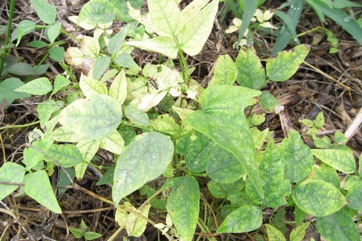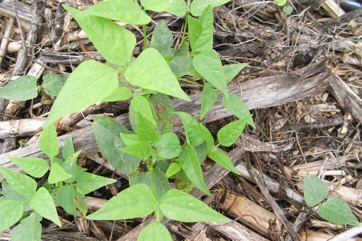Tepary bean

A tropical and subtropical plant. It can grow in hot dry regions. They do not do well in humid weather. It grows between 50 and 1920 m altitude. It requires an annual rainfall of 250-300 mm. It needs well drained soils. It needs a pH between 6.7-7.1. It can grow in arid places. It grows in the Sonoran Desert. It suits hardiness zones 8-11.
Also known as:
Frijol tepari, Pavi, Pawi, Tepari, Xmayum, Yori mui, Yorimuni
Synonyms
- Phaseolus montanus Brandegee
- Phaseolus tenuifolius (A. Gray) Wooton & Standl.
Edible Portion
- Seeds, Vegetable, Leaves
Where does Tepary bean grow?
Found in: Africa, Algeria, Australia, Botswana, Central Africa, Central America, Congo, Costa Rica, Côte d'Ivoire, Cuba, East Africa, El Salvador, Eswatini, Ethiopia, Gambia, Guatemala, Iraq, Israel, Ivory Coast, Kenya, Lesotho, Madagascar, Malawi, Mali, Mexico, Morocco, North Africa, North America, Senegal, South Africa, Southern Africa, Sudan, Swaziland, Uganda, United States, West Africa
Notes: There are about 20 Phaseolus species.
Status: It is a commercially cultivated vegetable.
Growing Tepary bean
Cultivation: Plants are grown from seed. Seed stored dry will remain viable for 3 years.
Edible Uses: The seeds are ground into flour and used for "instant" bean dishes. The seeds are eaten boiled or baked. They are used in soups and stews. The young tender pods are cooked and eaten. The leaves are tough so need to be cooked well.
Production: Plants flower 27-40 days after germination. They ripen 60-80 days after germination. Yields of 200-950 kg per ha are achieved. Yields are high with good fertiliser use.
Nutrition Info
per 100g edible portion| Edible Part | Energy (kcal) | Protein (g) | Iron (mg) | Vitamin A (ug) | Vitamin c (mg) | Zinc (mg) | % Water |
|---|---|---|---|---|---|---|---|
| Seeds dry | 353 | 19.3 | - | - | - | - | 8.6 |
Tepary bean Photos


References
Beckstrom-Sternberg, Stephen M., and James A. Duke. "The Foodplant Database." http://probe.nalusda.gov:8300/cgi-bin/browse/foodplantdb.(ACEDB version 4.0 - data version July 1994)
Burkill, H. M., 1985, The useful plants of west tropical Africa, Vol. 3. Kew.
Cobley, L.S. (rev. Steele, W.M.) 2nd Ed., 1976, An Introduction to the Botany of Tropical Crops. Longmans. p 90
Cundall, P., (ed.), 2004, Gardening Australia: flora: the gardener's bible. ABC Books. p 1022
Evans, A.M., 1979, Beans, in Simmonds N.W.,(ed), Crop Plant Evolution. Longmans. London. p 168
Facciola, S., 1998, Cornucopia 2: a Source Book of Edible Plants. Kampong Publications, p 109
FAO, 1993, Valor Nutritivo Y Usis en Alimantacion humana de Algunis Cultivos Autoctonos Subexplotados de Mesoamerica. FAO, Santiago, Chile. p 100
Grubben, G. J. H. and Denton, O. A. (eds), 2004, Plant Resources of Tropical Africa 2. Vegetables. PROTA, Wageningen, Netherlands. p 564
Hermandez Bermejo, J.E., and Leon, J. (Eds.), 1994, Neglected Crops. 1492 from a different perspective. FAO Plant Production and Protection Series No 26. FAO, Rome. p18, 52
ILDIS Legumes of the World http:www:ildis.org/Legume/Web
Jardin, C., 1970, List of Foods Used In Africa, FAO Nutrition Information Document Series No 2.p 27
Kays, S. J., and Dias, J. C. S., 1995, Common Names of Commercially Cultivated Vegetables of the World in 15 languages. Economic Botany, Vol. 49, No. 2, pp. 115-152
Kermath, B. M., et al, 2014, Food Plants in the Americas: A survey of the domesticated, cultivated and wild plants used for Human food in North, Central and South America and the Caribbean. On line draft. p 635
Kiple, K.F. & Ornelas, K.C., (eds), 2000, The Cambridge World History of Food. CUP p 1729
Macmillan, H.F. (Revised Barlow, H.S., et al) 1991, Tropical Planting and Gardening. Sixth edition. Malayan Nature Society. Kuala Lumpur. p 327
Miguel, E., et al, 1989, A checklist of the cultivated plants of Cuba. Kulturpflanze 37. 1989, 211-357
Moerman, D. F., 2010, Native American Ethnobotany. Timber Press. p 390
Mogotsi, K.K., 2006. Phaseolus acutifolius A.Gray. [Internet] Record from Protabase. Brink, M. & Belay, G. (Editors). PROTA (Plant Resources of Tropical Africa), Wageningen, Netherlands. < http://database.prota.org/search.htm>. Accessed 21 October 200919 October 2009
Purseglove, J.W., 1968, Tropical Crops Dicotyledons, Longmans. p 287
Royal Botanic Gardens, Kew (1999). Survey of Economic Plants for Arid and Semi-Arid Lands (SEPASAL) database. Published on the Internet; http://www.rbgkew.org.uk/ceb/sepasal/internet [Accessed 29th April 2011]
Self, M., 1999, Phoenix Seeds Catalogue p 3
Smith, K., 1998. Growing Uncommon Fruits and Vegetables. New Holland. p 28
van Wyk, B., 2005, Food Plants of the World. An illustrated guide. Timber press. p 288
Williamson, J., 2005, Useful Plants of Malawi. 3rd. Edition. Mdadzi Book Trust. p 195
Wilson, J.M. & Witcombe, J.R., Crops for Arid lands, in Wickens, G.E., Goodin, J.R., and Field, D.V.,(Eds.) 1985, Plants for Arid Lands. Unwin Hyman, London, p 41